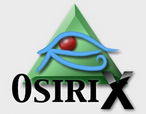Difference between revisions of "OsiriX"
Shawndouglas (talk | contribs) (Created as needed.) |
Shawndouglas (talk | contribs) (→External links: Removed standalone SF links so as to not encourage downloading from that site.) |
||
| Line 74: | Line 74: | ||
* [https://github.com/pixmeo/osirix OsiriX at GitHub] | * [https://github.com/pixmeo/osirix OsiriX at GitHub] | ||
* [http://foundation.osirixfoundation.com/ OsiriX Foundation] | * [http://foundation.osirixfoundation.com/ OsiriX Foundation] | ||
* [http://pixmeo.pixmeo.com/ Pixmeo] | * [http://pixmeo.pixmeo.com/ Pixmeo] | ||
Revision as of 19:06, 16 June 2015
 | |
| Original author(s) | Antoine Rosset |
|---|---|
| Developer(s) | Pixmeo |
| Initial release | April 23, 2004 (1.0.0)[1] |
| Stable release |
10.0.0 (October 1, 2018) [±] |
| Preview release | none [±] |
| Written in | Objective-C |
| Operating system | MacOS X |
| Type | Imaging informatics software |
| License(s) | GNU Lesser General Public License v3.0 |
| Website | osirix-viewer.com |
OsiriX is free open-source image processing software for managing DICOM images produced by radiology and nuclear imaging, functional imaging, 3D imaging, confocal microscopy, and molecular imaging. OsiriX also acts as a DICOM-compatible picture archiving and communication system (PACS) workstation for imaging.[2] The product is also offered as a commercial product, with a 64-bit and an FDA-approved professional version available for purchase.
Product history
OsiriX started out in November 2003 as a UCLA grant project of Antoine Rosset dedicated to learning about imaging informatics and writing "a small software program to convert DICOM files to a QuickTime movie file."[3] The project idea expanded to an open-source project, with a SourceForge project page being created on April 16, 2004.[4] Shortly afterwards, on April 23, a stable version 1.0 of the software was released.[1]
In March 2009, Rosset and his colleagues created the OsiriX Foundation to promote open-source software in Medicine. A year later the group spun off a new company called Pixmeo to certify OsiriX as a FDA-approved PACS and provide commercial support for OsiriX and other open-source solutions.[3]
Awards
In June 2005, the software was awarded "Best Use of Open Source" and runner-up for "Best Mac OS X Scientific Computing Solution" in the Apple Design Awards.[5]
Features
- DICOM file support
- DICOM network support
- Non-DICOM file support, including LSM, BioRadPIC, ANALYZE, TIFF, JPG, PNG, PDF, Quicktime, etc.
- 2-D viewer
- 3-D post-processing tools
- Optimized
- Extensible
For all features, see the "About" page.
Hardware/software requirements
The installation requirements for OsiriX include[6]:
- MacOS X 10.8 or higher
- Intel processor
For best performance, the following memory requirements should be met:
- 6 GB of RAM if you plan to open more than 800 images (CT & MRI, PET-CT)
- 8 GB of RAM for more than 1500 images (multi-slice CT & PET-CT) with OsiriX-64 bit
- 12 GB of RAM for more than 3000 images (cardiac or functional imaging) with OsiriX-64 bit
Videos, screenshots, and other media
- Online user guide
- DICOM sample image sets
- OsiriX instructional videos
Entities using OsiriX
A list of OsiriX users can be found here.
Further reading
External links
References
- ↑ Jump up to: 1.0 1.1 "Software Releases: Fri 23 Apr 2004". Mac Aggregate Tracker. Subsume Technologies, Inc. 23 April 2004. http://mat.subsume.com/2004/04/23.html. Retrieved 10 June 2014.
- ↑ "OsiriX Imaging Software - About OsiriX...". Pixmeo. http://www.osirix-viewer.com/AboutOsiriX.html. Retrieved 10 June 2014.
- ↑ Jump up to: 3.0 3.1 "Chapter 1: Introduction" (PDF). OsiriX User Guide. Pixmeo. pp. 1–3. http://www.osirix-viewer.com/UserManualIntroduction.pdf. Retrieved 10 June 2014.
- ↑ "OsiriX". SourceForge. http://sourceforge.net/projects/osirix/. Retrieved 10 June 2014.
- ↑ Cohen, Peter (10 June 2005). "WWDC: Apple Design Award 2005 winners announced". Macworld. IDG Consumer & SMB. http://www.macworld.com/article/1045262/design.html. Retrieved 10 June 2014.
- ↑ "OsiriX Imaging Software - Downloads". Pixmeo. http://www.osirix-viewer.com/Downloads.html. Retrieved 10 June 2014.









